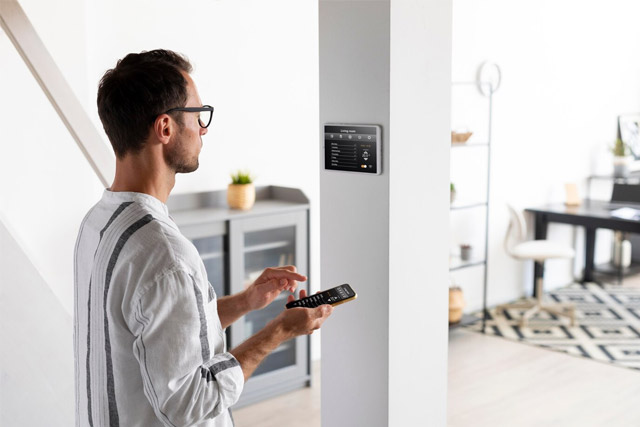Many older homes lack a C wire, posing a hurdle for smart thermostat compatibility. However, this limitation doesn’t mean you have to forfeit the benefits of smart heating and cooling. Explore the capabilities of smart thermostats, from tracking daily patterns to integrating with geofencing and voice-activated assistants like Alexa and Google Assistant.
1- Adapter Kits: Powering Up Without a C Wire

1.1. Power Solutions: Accessing Electricity
While most smart thermostats require a C wire, alternative power sources are available for those without one. Delve into the world of internal batteries, AA batteries, and power extender kits to keep your thermostat running smoothly.
1.2. Choosing the Right Adapter Kit: Compatibility Matters
Navigate the options of adapter kits, understanding the importance of compatibility with different thermostat brands. Whether internal batteries or power extenders, find the solution that suits your needs.
1.3. Tech Upgrade: Thermostat Replacement
Consider replacing your thermostat with a model that doesn’t require a C wire. While this may require professional assistance, it offers a quick and convenient upgrade for your heating system.
1.4. G Wire Tactics: An Advanced Approach
Learn about using the G wire strategically, connecting it to C terminals for specific functionalities. Understand the caution needed and the importance of professional expertise for this method.
Read More: TECH STARTUP IDEAS FOR 2024
1.5. Guide: How to Upgrade Your Thermostat for Smart Heating without a C Wire
If you’re considering a thermostat upgrade without a C wire, follow these steps for a seamless transition:
- Evaluate Your Current Wiring: Before choosing an upgrade path, assess your current thermostat wiring. Note the absence of a C wire and understand the existing connections.
- Research Compatible Smart Thermostats: Look for smart thermostats that specifically mention compatibility without a C wire. Brands like Nest, Ecobee, and Emerson offer options designed for such scenarios.
- Consider Power Source Alternatives: Explore internal batteries, AA batteries, or power extender kits as alternative power sources. Each option has its pros and cons, so choose based on your preferences and long-term convenience.
- Professional Installation vs. DIY: While some options allow for DIY installation, professional assistance ensures a secure setup, especially when dealing with advanced techniques like using the G wire as a substitute.
- Check Brand Compatibility: If opting for an adapter kit, verify its compatibility with your chosen thermostat brand. Not all kits work universally, so a thorough check is essential before purchasing.
- Explore New Thermostat Features: Use the upgrade opportunity to explore additional features offered by modern smart thermostats. Features like energy-saving modes, remote control, and voice activation can enhance your overall experience.
- Ensure Compatibility with Home Systems: Confirm that the chosen smart thermostat is compatible with your heating and cooling systems. Check voltage requirements and system types to avoid any installation issues.
Remember, a well-informed decision ensures a smooth transition to a smart thermostat without a C wire.
2- C-Wire Replacement: Troubleshooting for Optimal Performance

2.1. Understanding the C Wire: The Backbone of Smart Thermostats
In case of smart thermostat malfunctions, inspect the C wire. Understand its role and troubleshoot issues without resorting to extensive home rewiring.
2.2. Adapter Kits as a Solution: Avoiding Full Rewiring
Opt for adapter kits if a C wire is absent, utilizing a diode to divide voltage from an existing wire. Ensure professional installation for safety.
2.3. Battery-Powered Thermostats: An Energy-Efficient Alternative
Explore thermostats running on batteries, harvesting energy from HVAC systems to charge internal batteries. Similar to the Google Nest Thermostat, these solutions can lead to energy savings.
2.4. GEM’s Expertise: Affordable Rewiring Services
In case of discomfort with DIY solutions, seek GEM’s affordable rewiring service. Professional removal of old C wires and installation of new, functional ones ensures a reliable smart thermostat setup.
3- Smart Thermostats Without C Wires: Wireless Alternatives

3.1. Exploring Wireless Options: No C Wire Needed
For homes without a C wire, discover smart thermostats powered by batteries or adapters. Dive into DIY solutions, exploring the wiring behind your thermostat.
3.2. Energy Harvesting Marvels: Constantly Powered Thermostats
Learn about thermostats powered through energy harvesting, some with included adapter kits for easy installation. Notable examples include the Nest 3rd Generation.
3.3. Top Picks: Wireless Thermostats for Every Home
Explore options like the Ecobee 3 Lite and Emerson Sensi ST55 for homes without a C wire. Versatile devices compatible with various systems and networks.
3.4. Guide: Maximizing the Potential of Wireless Smart Thermostats
Embrace the freedom of wireless smart thermostats with these tips to make the most of your upgraded home climate control:
- Optimize Placement: Place your wireless thermostat strategically for optimal signal strength. Avoid thick walls or interference from electronic devices for seamless connectivity.
- Sync with Voice Assistants: If your chosen thermostat supports voice activation, sync it with popular voice assistants like Alexa or Google Assistant for hands-free control.
- Explore Mobile Apps: Take advantage of mobile apps provided by thermostat manufacturers. These apps often offer remote control, scheduling, and energy usage insights.
- Utilize Energy-Saving Modes: Discover and utilize energy-saving modes available on your wireless thermostat. These modes can help reduce energy consumption and lower utility bills.
- Stay Updated with Firmware: Regularly check for firmware updates for your thermostat. Manufacturers often release updates to enhance performance, fix bugs, and introduce new features.
- Integrate with Smart Home Ecosystems: If you have other smart home devices, explore integration possibilities. Syncing your thermostat with smart lights, locks, or sensors can create a cohesive smart home experience.
- Understand Battery Management: If your wireless thermostat relies on batteries, familiarize yourself with battery management. Keep spare batteries on hand and replace them promptly to avoid disruptions.
By following these tips, you’ll ensure a seamless and efficient experience with your wireless smart thermostat.
Read More: THE BENEFITS OF EV CHARGING STATIONS AT HOME
4- Getting Started: Your Guide to C-Wire-Free Smart Thermostats

4.1. Ease of Installation: Nest Learning Thermostat
Embark on your smart thermostat journey with easy-to-install options like the Nest Learning Thermostat. Ensure compatibility with your home’s systems.
4.2. Budget-Friendly Option: Ecobee 4
Consider the budget-friendly Ecobee 4, which offers compatibility without needing a C wire. While lacking certain functionalities, it remains a cost-effective choice for energy-conscious individuals.
4.3. C-Wire Essentials: Powering the Smart Thermostat
Understand the significance of the C wire in ensuring a continuous power supply for smart thermostats. Reliance on AA batteries can lead to frequent replacements and potential Wi-Fi disconnections.
4.4. Additional Wires: Enhancing Data Collection
Delve into the importance of additional wires like Y or W for smarter data collection and enhanced thermostat recommendations. Some smart thermostats demand these extra connections for optimal performance.
Conclusion
In the realm of smart thermostats, the absence of a C wire no longer impedes intelligent climate control. From innovative adapters to battery-powered options and strategic G wire use, achieving a C-wire-free home is diverse. Our picks include the Nest Learning Thermostat, budget-friendly Ecobee 4, and user-friendly Emerson Sensi ST55. Whether DIY or professional installation, the essence is comprehending your home’s wiring, ensuring compatibility, and making informed decisions. This journey signifies a commitment to energy efficiency, cost savings, and the evolving landscape of home automation. Explore options, stay informed, and revel in the limitless potential of smart heating and cooling.
FAQs:
While many smart thermostats do require a C wire, there are models designed to operate without one. Brands like Nest, Ecobee, and Emerson offer options for homes lacking a C wire.
While some adapter kits allow for DIY installation, it’s recommended to have a professional handle the installation, especially if you’re not familiar with your HVAC system’s wiring.
Turn off power at the thermostat’s breaker box, remove the thermostat, and inspect the wiring. The C wire is often blue, but it can be yellow, red, or green. If absent, explore alternative solutions like adapter kits.
Look for compatibility with power sources like batteries or adapter kits. Additionally, explore features like energy-saving modes, remote control capabilities, and compatibility with voice-activated assistants.
While it’s possible to use the G wire for specific functionalities, this method is advanced and should only be attempted by experienced professionals. GEM provides professional assistance for such installations.